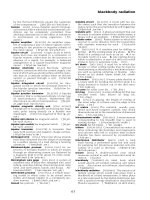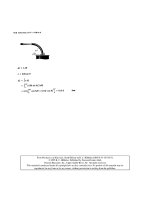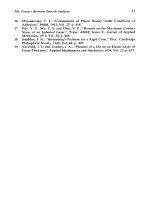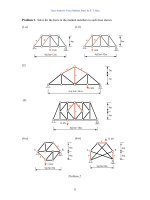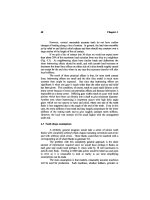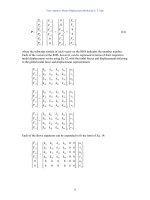Maintenance Fundamentals Episode 1 Part 4 docx
Bạn đang xem bản rút gọn của tài liệu. Xem và tải ngay bản đầy đủ của tài liệu tại đây (147.74 KB, 20 trang )
should maintain a two-way check on calibration. A simple means of doing this is
to have a small form for each instrument with a calendar of weeks or months
(depending on the interval required) across the top that can be punched and
noted to indicate the calibration due date. An example of this sort of form is
shown in Figure 5.4.
If the forms are sorted every month, the cards for each instrument that should be
recalled for check or calibration can easily be pulled out.
Month:
SN: 921355
User: Prototype Test Lab
Bldg 32, Rm 13
Attn: Mike Felluca
123
Tel: 334-9126
Due
−
Date
−
Act
12/ 1/97
6/ 1/98
12/ 1/98
12/ 1/98
12/ 4/97
6/15/98
8/ 3/98
JDP
HCF
JDP
OK
OK
Dropped. Repair/Recal.
By Comments
Acct: 121.355.722
Int: 6 mo.
Desc: Oscilloscope, Techtronix 213
45 7891011
Figure 5.4 A typical calibration card.
Keith Mobley /Maintenance Fundamentals Final Proof 14.6.2004 12:11pm page 54
54 Maintenance Fundamentals
6
MAINTENANCE ENGINEERING ROLES
AND RESPONSIBILITIES
The primary reason for establishing a maintenance engineering function is to
provide focus on asset reliability, maintainability, and life cycle cost for the entire
facility. Therefore the roles, responsibilities, and accountability of this function
must support these objectives. This fundamental requirement does not appear to
be a part of the assigned roles and responsibilities for the Phillip Morris group.
The observed deficiencies include:
1. The scope of equipment included in the maintenance engineering group’s
area of responsibility is limited to ‘‘production’’ equipment. By defin-
ition, or as interpreted, this excludes most of the infrastructure (electrical
distribution, steam generation/distribution, compressed air/gases, etc.).
In addition, other critical assets, such as cranes, are excluded.
2. Inconsistent vision of the true role of the maintenance engineering
function. In its current configuration, there are 34 tasks or roles
defined for the maintenance engineering function. While all of these
appear to be valid activities, they do not fully define the role and
responsibility of an effective functional group.
The role of an effective maintenance engineering function is to provide the pro-
active leadership, direction, and technical support required to achieve and sustain
optimum reliability, maintainability, and life cycle cost for the facility’s assets.
While maintenance engineering cannot directly affect facility performance, its
responsibility is to provide facility and functional management with accurate,
Keith Mobley /Maintenance Fundamentals Final Proof 14.6.2004 12:14pm page 55
55
timely data that can be used to optimize maintenance and facility strategies that
will support continuous improvement and ultimately result in world-class per-
formance.
The responsibilities or duties that the function provides include:
v Develop criteria for effective maintenance management
Ø Methods to optimize maintenance strategy
Evaluate current practices versus best practices
Develop recommendations to correct deficiencies
Methods to validate preventive and corrective maintenance ac-
tivities
Analyze preventive maintenance activities versus breakdown his-
tory by asset type, area, and classification
Evaluate and upgrade individual preventive maintenance task
lists and work orders in suspect areas, asset types and classifica-
tions
Ø Methods to improve quality of work performed
Evaluate complete tasks, call-backs, reworks
Audit random executions of preventive and corrective activities
Skills assessments
Ø Methods to reduce maintenance workload
Evaluate maintenance history to determine proper periodicity
and scope
Evaluate maintenance prevention methods that reduce mainten-
ance requirements
Develop configuration management procedure to ensure reliabil-
ity, maintainability, and best life cycle cost are followed in ac-
quisition/modification of assets
Evaluate planning/scheduling effectiveness
v Improve asset reliability
Ø Ensure reliability and maintainability of new/modified installations
Develop configuration management procedure
Active participant in specification, procurement and installation
of new assets or upgrades/modifications
Perform site acceptance tests, using predictive maintenance tech-
nologies, to verify inherent reliability of new/modified critical
assets
Perform root-cause failure analysis on breakdowns and abnor-
mal asset operation
Ø Identify and correct inherent design/installation/operation prob-
lems
Keith Mobley /Maintenance Fundamentals Final Proof 14.6.2004 12:14pm page 56
56 Maintenance Fundamentals
Perform simplified failure modes and effects analysis on critical
assets
Periodic evaluation of asset histories
Periodic testing, using predictive technologies, to identify incipi-
ent reliability problems
Verify and validate standard procedures (SOPs, PMs, and work
orders)
Develop/modify PMs and work orders for critical assets
Ø Improve life cycle costs
Maintain and analyze equipment data and history records to
predict future maintenance needs
Develop effective procedures for inspection, adjustments, MRO
parts, asset replacements, overhauls, etc. for critical assets
Ensure assets are properly designed, selected, installed, operated,
and maintained based on life cycle cost philosophy
Monitor and evaluate asset performance
Review asset deficiencies and implement corrections
Perform periodic cost-benefit evaluations
Identify and correct chronic and/or costly asset problems
Ø Provide technical support
Maintenance manager
Planners/schedulers
Supervisors/foremen
Maintenance crafts
Procurement
Ø Plant Engineering
CONFIGURATION MANAGEMENT
Statistically, at least 85% of all reliability, asset utilization, and high life cycle
cost problems are directly attributable to deficiencies in or total lack of enforced
configuration management. Our database, as well as those developed by other
consulting firms, indicates that the functional responsibility for these problems
break out as follows:
23% caused by deficiencies in the production or operations function.
The majority of these deficiencies are caused by a lack of valid, en-
forced operating procedures, poor skills, and unknown operating re-
quirements of facility assets. A viable configuration management
process could eliminate almost all of these forcing functions.
17% caused by deficiencies in the maintenance function. Again, the
majority of these deficiencies are caused by a lack of effective or
Keith Mobley /Maintenance Fundamentals Final Proof 14.6.2004 12:14pm page 57
Maintenance Engineering Roles and Responsibilities 57
enforced configuration management that predetermines the mainten-
ance activities required to achieve and sustain asset reliability and that
support best life cycle costs.
12% caused by deficiencies in the procurement process. In addition to
mistakes made during the procurement of new capital assets, these
deficiencies are caused by the lack of an effective procedure that
governs the replacement of operating and maintenance spare parts.
Again, an effective, enforced configuration management process would
eliminate most of these deficiencies.
22% caused by plant or maintenance engineering. Most of these prob-
lems are caused by a lack of a formal procedure that can be used to
evaluate the impact on reliability, availability, maintainability, and life
cycle cost caused by modification or upgrades to existing facility assets.
In addition, the lack of formal procedures directly and negatively
affects the procurement of new or replacement assets.
11% caused by management philosophy. The majority of these defi-
ciencies are caused by business decisions that are based on faulty data.
Too many business decisions are made on opinions, perceptions, or
intuitive judgments, and in most cases they are the wrong decisions.
Implementing and enforcing an effective configuration management
process could resolve at least one half of these deficiencies. The discip-
line and absolute adherence to standard procedures used to develop
business plans, requests for capital expenditures, key performance
indicators, and the myriad other information that senior managers
rely on to make business decision will greatly increase the probability
that the correct decision will be made.
15% caused by deficiencies in the sales and marketing function. The
primary forcing function caused by sales is the method used to load the
facility. The loading directly affects equipment utilization, production
schedules, and maintenance activities. In effect, the way that sales
loads the facility to a large degree determines the resultant reliability
and life cycle cost of its assets. Normally, configuration management
does not directly address the sales function’s contribution to facility
performance. However, procedures can and should be included that
will minimize any negative effect that facility loading would cause.
Definitions of Configuration Management
There are two classic definitions of configuration management. The first is the
methodology of effectively managing the life cycle of the major asset, in this case
the shipyard. This type of configuration management governs the development
of strategic and tactical plans that will optimize the useful life of the facility and
is based on traditional life cycle management concepts.
Keith Mobley /Maintenance Fundamentals Final Proof 14.6.2004 12:14pm page 58
58 Maintenance Fundamentals
Total Facility Configuration Management
Key components, as shown in Figure 6.1, of this form of configuration manage-
ment include the following.
Program Management This component includes the management plan; the def-
inition of the critical elements that comprise the facility; and the definition of all
interfaces, databases, and procedures that are needed to support a life-of-facility
management program.
Design Requirements This component establishes the design requirements,
system and process boundaries, specific asset or equipment lists, and engineering
design basis that must be maintained for the facility. The procedure clearly
defines how each step of the design and/or change process will be performed.
Document and Control This component identifies all of the documents, docu-
ment storage requirements, document controls and tracking, and retrieval
Program
Planning
Establish Design
Requirements
Identification of
Documents
Identification of
Change
Program
Assessments
Condition
Assessments
Periodic
Performance
Post-Modification
Testing
Materials Condition &
Aging Management
Program Plans
and Procedures
Component
Screening
Aging Degradation
Evaluations
Estimates of
Facility Remaining
Life
Feasibility of
Continued
Operation
Feasibility of
Extended Life
Operation
Degradation
Trending, Aging
Management and
Life Extension
Technical Reviews
Management
Reviews
Implementation of
Change
Documentation of
Change
Configuration
Management
Storage Methods
and Requirements
Control and
Tracking
Document
Retrieval
Process
Boundaries
Equipment Lists
Establish Design
Basics
Equipment Scope
Criteria
Concepts and
Terms
Interfaces
Database
Procedures
Design Reconstruction
Program Plans
and Procedures
Retrieval of
Design
Information
Validation of
Design
Information
Regeneration of
Design
Information
Preparation of
Design
Information
Issuance of
Design
Information
Program Management
Design Requirements
Document Control
Change Control
Assessment
Figure 6.1 Configuration management.
Keith Mobley /Maintenance Fundamentals Final Proof 14.6.2004 12:14pm page 59
Maintenance Engineering Roles and Responsibilities 59
requirements that are needed to support effective life cycle asset management.
Documentation is a key requirement of effective configuration management. In a
facility with effective configuration management, nothing can be done without
proper documentation. Flying by the seat of your pants is simply not permitted.
Change Control This involves development and implementation of standard
procedures to control configuration changes. The procedures provide specific
methodology to identify, evaluate, manage, implement, and document changes.
Assessments The key to this type of configuration management is periodic assess-
ments that quantify the condition of the shipyard and all of its assets. These
assessments include physical configuration, criticality, condition, remaining useful
life, life cycle costs, equipment performance (predictive maintenance), and other
analyses or testing that quantify effectiveness.
Asset Condition and Aging Management This component is focused on useful life
extension of the facility and its assets. It includes specific management methods
and standard procedures that are designed to continuously evaluate asset condi-
tion and to develop effective means of extending useful life of assets. Generally,
analyses that are used by this part of the configuration management process
include aging degradation, feasibility of continued operation, and feasibility of
extended operation.
This level of configuration management literally affects the entire organization.
It provides standard procedures that define all aspects of day-to-day operations
as well as the tactical and strategic planning process that will govern future
actions. All of these procedures are predicated on the optimization of the
shipyard for as long as it is feasible to continue operations.
ENGINEERING CHANGE MANAGEMENT
The second definition of configuration management, as illustrated in Figures 6.2
Level 1 and Level 2, is a subset of the first and is focused on effective management
of the individual components (assets) that make up the shipyard. Normally, this
process is known as engineering change management or life cycle costs manage-
ment and governs all aspects of facility operations as they relate to the assets
including all materials such as consumables, maintenance materials, drawings,
training, etc. that directly or indirectly affect these assets. At the global level,
these concepts are similar, but there are differences in the more detailed levels of
the process. Both processes are intended to bring logic and discipline to the
process of managing the life cycle cost of facility assets. An effective process
should ensure that all decisions that directly or indirectly affect reliability,
Keith Mobley /Maintenance Fundamentals Final Proof 14.6.2004 12:14pm page 60
60 Maintenance Fundamentals
Life Cycle
Analysis
Procedure
Document
and Upgrade
Library
Incoming
Inspection
Purchasing
Specifications
Financial
Analysis
Functional
Specification
Procurement
Package
Vendor
Qualification
Proposal
Evaluation
Justify
Variances
Installation
Document
and Upgrade
Library
Yes
No
Chagne
Request
Procure
Submit
RFQ
Vendor
Selection
Modify
PMs
Modify
Drawings
Modify
BOMs
Modify
MRO
Spares
Modify
Capacity
Modify
Planning
Modify
Operating
Spares
Modify
SOPs
Retrain
Crafts
Retrain
Operators
Is Request
Valid
Yes
Yes
No
Capital
Project
Complete
Compliance
Figure 6.2 Level 1 Engineering change management.
Keith Mobley /Maintenance Fundamentals Final Proof 14.6.2004 12:14pm page 61
Maintenance Engineering Roles and Responsibilities 61
Life Cycle
Analysis
Procedure
Is Change
Necessary?
Yes
Evaluate Life
Cycle Impact
Procedure
Is it
Technically
Correct?
Is there
Alternative?
Cost-Benefit
Analysis
Procedure
Is Change
Justifiable?
Change
Management
Procedure
Update
Drawings
Yes
Yes
Drawing
Change
Procedure
Update
BOM
Bill of
Material
Change
Procedure
Update PMs
Yes
Yes
Yes
Yes
PM Change
Procedure
Upgrade
Skills
Training
Procedures
Upgrade
Safety
Safety
Procedures
Upgrade
Stores
MRO
Inventory
Procedures
Cost-Benefit
Analysis
Procedure
Is Change
Justifiable?
Yes
Justification
Package
Procedure
File
No
No
No
No
No
No
No
No
Document
No
No
Figure 6.2 Level 2 Engineering change management.
Keith Mobley /Maintenance Fundamentals Final Proof 14.6.2004 12:14pm page 62
62 Maintenance Fundamentals
maintainability, life cycle cost, and financial performance of the facility are based
on best practices (i.e., thorough analysis based on factual data and a disciplined
decision-making process).
Configuration Management for New Assets
Configuration management for the acquisition of new assets or major modifica-
tion of existing assets must include specific procedures that define how to
perform the following tasks:
1. Justify the need (for new or replacement systems, assets or equip-
ment): All asset owners, engineering, and other function groups or
individuals that are authorized to prepare a justification package will
use this procedure. By using a standard procedure, senior manage-
ment will be able to evaluate the real need for the recommended
acquisitions.
2. Comprehensive engineering evaluation: A standard procedure that
governs every step of the engineering evaluation for requests that
are initially authorized by senior management. The procedure should
include (1) technical analysis of requested system, asset or equipment;
(2) evaluation of changes within the facility that will result from the
change; and (3) development of a project plan to procure, implement
and turn over the new system, asset or equipment, including all
changes in documentation, training, procedures, capital spares, main-
tenance spares, etc. The procedure should also include the cost-benefit
methodology that is needed to verify the need and the expected life
cycle cost of the new asset.
3. Functional specifications: A procedure that governs the development
of a comprehensive functional specification for the requested asset.
This specification should include all of the data included in Procedure
2. This specification will be used for the procurement of the asset. It
should include all labor and material requirements that should be
provided by the vendor, contractors, and company. In addition, it
should include all internal changes (i.e., training, drawings, proced-
ures, spare parts inventory, etc.) caused by the inclusion of the new or
replacement asset. The functional specification should include specific
testing, acceptance, and documentation requirements that the vendor
or others are to provide as part of the procurement or because of the
procurement.
4. Procurement package: A procedure that ensures inclusion of all tech-
nical, financial, training, and other requirements that the vendor is
expected to provide as part of the procurement. In addition, the
package should include specific acceptance criteria, delivery dates,
Keith Mobley /Maintenance Fundamentals Final Proof 14.6.2004 12:14pm page 63
Maintenance Engineering Roles and Responsibilities 63
penalties for off-specification or timeline, and other pertinent re-
quirements that the vendor is expected to meet.
5. Qualified vendor selection: A specific procedure that is universally
used to prequalify vendors for the procurement of assets, spares,
consumables, and other materials and services that are needed to
support the operation and maintenance of the facility. An effective
prequalification procedure improves the potential for acquiring new
or replacement assets that will support best life cycle cost.
6. Proposal evaluation: A formal procedure that governs the evaluation
process for new and replacement assets. The procedure should in-
clude all steps required to evaluate the technical merit, life cycle cost,
and long-term support that each potential vendor will provide as
part of its proposal.
7. Proposal acceptance: The procedure that determines the logic that
will be used to select the asset and vendor that will be procured. The
acceptance criteria should be based on reliability, maintainability,
and best projected life cycle cost.
8. Installation: A procedure that governs the methods and acceptance
criteria that will be followed for the installation, testing, startup, and
turnover of new and replacement assets. The procedure should in-
clude all probable combinations of turnkey, contractor, and in-house
installations.
9. Acceptance: The engineering analysis, procurement package, and
vendor submittal should include a specific method for factory and
site acceptance testing that must be completed before the procured
assets or system will be accepted.
10. Standard operating procedures: This procedure should include the
methods that must be followed to ensure that all changes within the
facility caused by the procurement of the new or replacement asset
are made. Typically, these changes include modification or replace-
ment of standard operating procedures, additional training, as well
as possible changes in production materials.
11. Standard maintenance procedure: This procedure should include
the methods that must be followed to ensure that all changes
within the facility caused by the procurement of the new or replace-
ment asset are made. As in operations, this includes standard pro-
cedures, preventive maintenance tasks, maintenance spares, training,
drawings, bill of materials, special tools, and a variety of other
changes.
12. Configuration change: This procedure defines the methodology that
must be followed to make any change to installed assets or facility
configuration. The procedure should include all modifications (i.e.,
Keith Mobley /Maintenance Fundamentals Final Proof 14.6.2004 12:14pm page 64
64 Maintenance Fundamentals
bill of materials, drawings, operating/maintenance procedures,
manning levels, required skills, etc.) that will result from the change.
In addition, the procedure should provide clear procedures that
require a thorough engineering and financial evaluation of any pro-
posed change before it is submitted for approval as well as proced-
ures for the approval and implementation process.
13. Decommissioning: This procedure governs the final decommission-
ing of the asset or assets when they reach the end of their useful life.
The procedure should include removal, disposal, and possible re-
placement of the asset. It should provide specific instructions for
assets or systems that may affect safety, environmental compliance,
and other regulatory issues.
Configuration Management of Existing Assets
Configuration management for existing assets and governing direction for day-
to-day operating of the facility should utilize most of the procedures defined
above. Therefore the individual modules should be written to include specific
directions for capital procurement, direct replacement of assets that do not
justify a major capital procurement, changes in configuration (i.e., form, fit
and function of facility systems), changes in mission, and other potential reasons
that force a change in production or maintenance practices. In addition, the
procedures should provide clear, concise procedures that are designed to prevent
any change to the infrastructure or assets that is not based on thorough analysis
of its effect the facility’s ability to meet its mission requirement as well as
reliability, maintainability, and life cycle cost.
The key to successful configuration management is documentation of all pro-
posed and implemented changes and a universal (i.e., standard) methodology
for implementing any change in the configuration or makeup of the facility.
The level of documentation will be substantial and should be compatible with
the SAP Enterprise information management system. As a point of information,
SAP has a configuration management module that can be fully integrated into
the facility’s existing system. I have no direct experience with this module but
understand that it will provide the means to ensure documentation control and
facilitate the configuration management development process.
It should be noted that this description is only an overview of the myriad
parameters that must be covered by an effective configuration management
procedure. The level of detail required and the impact on most of the functional
groups within the facility is substantial. However, any attempt to shortcut or
simplify the process will seriously limit the benefits that could be derived.
Keith Mobley /Maintenance Fundamentals Final Proof 14.6.2004 12:14pm page 65
Maintenance Engineering Roles and Responsibilities 65
REASONS FOR STANDARD PROCEDURES
The need for procedures is indicated when an organization is faced with decision
options that may be precedent-setting. Situations calling for procedures include
those in which
Opinions may differ over the best course of action in situations that
affect the achievement of overall mission and goals.
Decisions may have significant consequences beyond the local level at
which they are made.
The choice of action may lead to unnecessary risk, counter-productiv-
ity, inefficiency, or conflict.
Cooperation and reciprocal actions on the part of one organizational
element are needed to enable another element to function effectively.
Procedures may be established to
Clarify Define Guide
Regulate Direct Establish
Integrate Authorize Enable
Empower Commit Support
Provide Admit Prohibit
Ensure Inhibit Standardize
Restrict Disallow
Reliability procedures are needed at a number of levels in the organization to
ensure reliability creation, reliability maintenance, and reliability improvement.
They are especially needed to smooth the way for key or critical matters. Firms
establishing a new reliability function have a compelling need for them; firms
engaged in the manufacture and sale of products or systems that can present a
significant public safety hazard or can affect national security or national pres-
tige have a critical need for them.
To be effective, reliability procedures must issue from high-level management.
Management’s attitude toward reliability, as expressed through procedures, is
the most important single ingredient in making maintenance engineering and
reliability assurance a successful practice in any organization. If the deeds of
management in fact support written procedures, procedures gain credibility and
legitimacy and will be respected.
Reliability procedures and, ultimately, the final responsibility for the reliability
of products and services rest on the chief executive officer, albeit through
successive management levels. The top assurance executive is responsible for
pursuing reliability in the manner and to the extent prescribed by general
Keith Mobley /Maintenance Fundamentals Final Proof 14.6.2004 12:14pm page 66
66 Maintenance Fundamentals
management procedures and establishes his or her own procedures in support of
this function.
Attributes of Procedures
Procedures, in general, should be as follows:
a. Action-oriented (as contrasted to mere statement of belief)
b. Supportive of organizational goals
c. Consistent with other procedures
d. Authoritative, credible, and acceptable at the level of implementation
e. Inclusive to the extent of embracing all aspects of the intended appli-
cation
f. Specific to the extent of providing unambiguous direction and focus
g. Admissive to the extent of allowing maximum flexibility of choice
within the prescribed framework of guidance or direction
h. Concise and readily understandable
i. Relevant to the times and circumstances
j. Stable over relatively long periods of time
Types and Levels of Procedures
Procedures are established at all levels of the organization, beginning at the
corporate level and proceeding through divisional levels and successively finer
levels of organizational structure down to departments and functional units.
High-level procedures such as those at the corporate level are broad and general
to deal effectively with the broad concerns of top-level management. Corporate
reliability procedures provide for the establishment and promotion of reliability
activity and achievement to fulfill obligations to customers and to society. They
deal with internal matters pertaining to overall performance and with external
matters pertaining to relationships with customers, the community, and involve-
ments with regulatory and other such organizations. It sponsors the reliability
function by declaring its intentions to the organization at large and provides for
review and evaluation of the overall reliability system.
Divisional procedures respond to corporate procedures and relate to the more
specific issues encountered by departments and functional units. Typically, they
deal with administration, organizational interrelationships, operating methods,
and the maintenance or improvement of organizational performance. Depart-
mental procedures deal with situations and conditions more apt to arise on a
day-to-day basis. These situations typically include matters relating to suppliers,
subcontractors, product design activities, parts and materials, manufacturing,
testing, auditing, and reviewing.
Keith Mobley /Maintenance Fundamentals Final Proof 14.6.2004 12:14pm page 67
Maintenance Engineering Roles and Responsibilities 67
Developing and Establishing Procedures
The formation of effective and lasting procedures requires a comprehensive view
of the issues and a full appreciation of the circumstances leading to the need for
procedures. If the procedures developer is not in full possession of the facts and
nuances, it is advisable to enlist the views of others who may be deeply involved
in the situation and have the breadth of view, knowledge, judgment, and experi-
ence to make constructive contributions. It is desirable that managers and
supervisors who would be affected by the procedures or who would be expected
to carry them out should be considered as potential contributors. Not only can
their views be constructive, their involvement in developing the procedures will
increase their acceptance and support when the procedures go into effect.
Although the participative approach is useful, the responsible manager nonethe-
less must impress the force of office and provide the benefit of experience to
create appropriate procedures.
It is especially important to the formation of procedures for a new reliability
function to win the acceptance and cooperation of long-established groups,
particularly those that play prominent roles in the organization. Key individuals
from those groups brought into the definition and development phases of pro-
cedures formation can help ensure well-conceived procedures by raising key
issues to address.
While the development of many procedures is straightforward, some procedures
are more involved and may require advance planning and study. To assist in such
cases, the following outline is presented as a guide.
General Guide for Procedures Development
Effective procedures should follow well-defined guidelines that include the
following:
1. State the need. Describe the situation that created the need. Identify
who or what is involved, how they are involved, and to what extent.
2. Identify and review any existing procedures that relate to the situation.
3. Survey managers and supervisors who will be affected by the new
procedures. Obtain pros and cons.
4. Determine if a new procedure is actually needed or if existing proced-
ures should be revised to accommodate the situation.
5. Draft a preliminary procedure statement for review and comment by
the departments affected. Include purpose and scope.
Keith Mobley /Maintenance Fundamentals Final Proof 14.6.2004 12:14pm page 68
68 Maintenance Fundamentals
6. Integrate appropriate suggestions and prepare a revised statement for
additional review. Add sections on responsibilities and actions, if
appropriate.
7. Check the procedure against the attributes presented in the preceding
section and prepare a final document.
8. With executive approval and sign off, release the document for distri-
bution.
Procedures are communicated by memoranda, letters, instructions, or directives
and are included in program plans and various manuals. They are given visibility
by way of meetings, workshops, lectures, and training sessions. New procedures
should be routed to all departments and units affected and acknowledged by
signature and date.
Procedure statements range in size from simple statements of a paragraph or two
in length to comprehensive documents that may include some or all of the
following topics:
Background
Procedures
Purpose
Responsibility
Scope
Actions
Definitions
While procedures are essential to effective and efficient operations, they should
be held to the minimum allowed by size of organization; complexity of oper-
ations; criticality of processes; management style; and self-responsibility, aware-
ness, and professional level of employees. As guiding forces, they should admit
the widest possible latitude for action any given situation allows.
Procedures should be reviewed for possible revision or cancellation on a sched-
uled basis and whenever major changes are made in organization, management,
practice, or overall organizational strategy.
The absence of a formal, universally followed configuration management pro-
cedure is a known cause of less-than-acceptable facility performance. Partial
procurement specifications, as well as undocumented changes to installed assets,
are a major contributor to chronic reliability problems that result in serious loss
of capacity and excessive life cycle costs.
Keith Mobley /Maintenance Fundamentals Final Proof 14.6.2004 12:14pm page 69
Maintenance Engineering Roles and Responsibilities 69
To the best of our knowledge, none of the required configuration management
modules outlined above exist in the facility. Therefore the development process
will literally be from a clean sheet of paper. Our best estimate is that will require
a minimum of one (1) man-year to complete the initial procedure and will
require the active participation of most of the functional groups that comprise
the facility. As a minimum, the effort will require active input and/or participa-
tion from:
Plant engineering
Maintenance engineering
Planning (business and maintenance)
Procurement
Labor relations
Human resources
Production
Maintenance
Customer relations
Materials management
Project management
Asset owners
Cost accounting.
Because the resultant procedure must include multiple functional groups (i.e.,
plant engineering, procurement, training, human resources, etc.), this task
cannot be completed by maintenance engineering, the maintenance organization,
or any other single functional group within the facility. The best way to proceed
is to assign, with the approval of the functional managers, a cross-functional
team to develop the procedure. As a minimum, this team should include repre-
sentatives of plant engineering, maintenance engineering, project management,
production, procurement, and financial management. Since these functional
groups play the greatest role in the configuration management process, they
are best suited to develop the procedures. The assigned team will need input
from other individuals and/or groups but should be able to develop a mutually
agreeable and effective procedure.
Keith Mobley /Maintenance Fundamentals Final Proof 14.6.2004 12:14pm page 70
70 Maintenance Fundamentals
7
SHAFT ALIGNMENT
Shaft alignment is the proper positioning of the shaft centerlines of the driver
and driven components (i.e., pumps, gearboxes, etc.) that make up the machine
drive train. Alignment is accomplished through either shimming or moving
a machine component or both. Its objective is to obtain a common axis of
rotation at operating equilibrium for two coupled shafts or a train of coupled
shafts.
Shafts must be aligned as perfectly as possible to maximize equipment reliability
and life, particularly for high-speed equipment. Alignment is important for
directly coupled shafts as well as coupled shafts of machines that are separated
by distance—even those using flexible couplings. It is important because mis-
alignment can introduce a high level of vibration, cause bearings to run hot, and
result in the need for frequent repairs. Proper alignment reduces power consump-
tion and noise level and helps to achieve the design life of bearings, seals, and
couplings.
Alignment procedures are based on the assumption that one machine-train
component is stationary, level, and properly supported by its base plate and
foundation. Both angular and offset alignment must be performed in the vertical
and horizontal planes, which is accomplished by raising or lowering the other
machine components and/or moving them horizontally to align with the rota-
tional centerline of the stationary shaft. The movable components are designated
as machines to be moved (MTBM) or machines to be shimmed (MTBS). MTBM
generally refers to corrections in the horizontal plane, while MTBS generally
refers to corrections in the vertical plane.
Keith Mobley /Maintenance Fundamentals Final Proof 15.6.2004 4:57pm page 71
71
Too often, alignment operations are performed randomly, and adjustments are
made by trial and error, resulting in a time-consuming procedure. Because of this
problem, Integrated Systems, Inc. (ISI) developed this module to help mainten-
ance technicians speed up the alignment process. It presents a step-by-step
procedure for the proper alignment of machinery and discusses shaft alignment
fundamentals, equipment, measurements, and computations. Because there are
certain basic math skills needed to perform alignment computations, a math
review also is included.
FUNDAMENTALS
This section discusses the basic fundamentals of machine alignment and
presents an alternative to the commonly used method, trial and error. This
section addresses exactly what alignment is and the tools needed to perform
it, why it is needed, how often it should be performed, what is considered to
be ‘‘good enough,’’ and what steps should be taken prior to performing
the alignment procedure. It also discusses types of alignment (or misalignment),
alignment planes, and why alignment is performed on shafts as opposed to
couplings.
Shafts are considered to be in alignment when they are colinear at the coupling
point. The term colinear refers to the condition when the rotational centerlines of
two mating shafts are parallel and intersect (i.e., join to form one line). When this
is the case, the coupled shafts operate just like a solid shaft. Any deviation from
the aligned or colinear condition, however, results in abnormal wear of machine-
train components such as bearings and shaft seals.
Variations in machine-component configuration and thermal growth can
cause mounting-foot elevations and the horizontal orientations of individual
drive-train components to be in different planes. Nevertheless, they are con-
sidered to be properly aligned as long as their shafts are colinear at the coupling
point.
Note that it is important for final drive-train alignment to compensate for actual
operating conditions because machines often move after start-up. Such move-
ment is generally the result of wear, thermal growth, dynamic loads, and support
or structural shifts. These factors must be considered and compensated for
during the alignment process.
Tools most commonly used for alignment procedures are dial indicators, adjust-
able parallels, taper gauges, feeler gauges, small-hole gauges, and outside
micrometer calipers.
Keith Mobley /Maintenance Fundamentals Final Proof 15.6.2004 4:57pm page 72
72 Maintenance Fundamentals
WHY PERFORM ALIGNMENT AND HOW OFTEN?
Periodic alignment checks on all coupled machinery are considered to be one of the
best ‘‘tools’’ in a preventive maintenance program. Such checks are important
because the vibration effects of misalignment can seriously damage a piece of
equipment. Misalignment of more than a few thousandths of an inch can cause
vibration that significantly reduces equipment life.
Although the machinery may have been properly aligned during installation or
during a previous check, misalignment may develop over a very short period of
time. Potential causes include foundation movement or settling, accidentally
bumping the machine with another piece of equipment, thermal expansion,
distortion caused by connected piping, loosened hold-down nuts, expanded
grout, rusting of shims, etc.
Indications of misalignment in rotating machinery are shaft wobbling, excessive
vibration (in both radial and axial directions), excessive bearing temperature (even
if adequate lubrication is present), noise, bearing wear pattern, and coupling wear.
TRIAL-AND-ERROR VERSUS CALCULATION
Many alignments are done by the trial-and-error method. Although this method
may eventually produce the correct answers, it is extremely time-consuming and,
as a result, it is usually considered ‘‘good enough’’ before it really is. Rather than
relying on ‘‘feel’’ as with trial-and-error, some simple trigonometric principles
allow alignment to be done properly with the exact amount of correction needed,
either measured or calculated, taking the guesswork out of the process. Such
accurate measurements and calculations make it possible to align a piece of
machinery on the first attempt.
WHAT IS GOOD ENOUGH?
This is a difficult question to answer, because there are vast differences in
machinery strength, speed of rotation, type of coupling, etc. It also is important
to understand that flexible couplings do not cure misalignment problems—a
common myth in industry. Although they may somewhat dampen the effects,
flexible couplings are not a total solution.
An easy (perhaps too easy) answer to the question of what is good enough is to
align all machinery to comply exactly with the manufacturers’ specifications.
However, the question of which manufacturers’ specifications to follow must be
answered, as few manufacturers build entire assemblies. Therefore an alignment
is not considered good enough until it is well within all manufacturers’ tolerances
Keith Mobley /Maintenance Fundamentals Final Proof 15.6.2004 4:57pm page 73
Shaft Alignment 73
